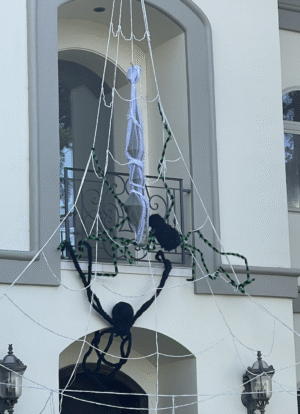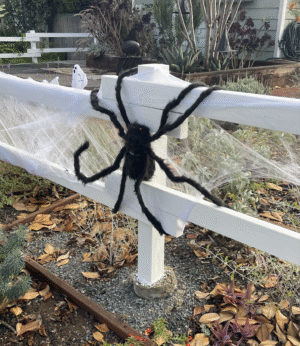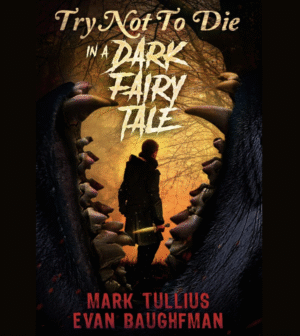Halloween Haunts: SPIDER SEASON
By Evan Baughfman
Recently, I picked Arachnophobia for our Family Movie Night, and my kids (over)reacted as if I’d told them we’d be bobbing for egg sacs inside a squirming tub of tarantulas. They begged for Ghostface, Annabelle, and KPop demons.
Anyone or anything but SPIDERS!
Arachnids have been creeping through my brain since end-of-summer. (To be honest, they’re always there, just out of view. Spiders like to crawl into my horror fiction, whether it be a twisted fairy tale or a dark Christmas entry.) It’s that time of year when orb-weaver species are on full display in my Southern California neighborhood, their intricate webs stretching across bushes, gates, fences, rain gutters, and every other place I look on my morning walks.
Sidewalks themselves are home to the weavers, too, especially the pathways beneath low-lying tree branches. I’ve stumbled through many invisible-until-I’m-in-them webs, no doubt disappointing countless spiders with the fact that they’ve caught a clumsy, four-eyed kaiju instead of a tasty butterfly or mosquito. I wonder how many of my neighbors’ Ring cameras have recorded me doing the funky check-my-hair-and-clothes-for-eight-legs shuffle?
 While getting my A.M. steps in, I’ve noticed Halloween decorations blooming in people’s yards, as well. Multiple set-ups showcase giant spiders dangling from roofs or looming over garage doors. Nothing says “October” more than arachnids run amok. Real or purchased online, the creatures seem to be everywhere.
While getting my A.M. steps in, I’ve noticed Halloween decorations blooming in people’s yards, as well. Multiple set-ups showcase giant spiders dangling from roofs or looming over garage doors. Nothing says “October” more than arachnids run amok. Real or purchased online, the creatures seem to be everywhere.
Spiders: prominent mascots of the spooky season.
Which isn’t surprising, of course. Many stories and films utilize spiders to illicit fear and/or feelings of pure WTF. Here are just a few examples:
-Shelob, one of the Hobbits’ nemeses, from The Lord of the Rings
-the entity’s final form in Stephen King’s It—a massive arachnIt
-face-hugging alien-arachnids from the Alien franchise
-the decapitated head-spider from John Carpenter’s The Thing
-Rottweiler-sized spiders spraying corrosive web strands in The Mist (novella and film)
-the bizarre transformation of Jake Gyllenhaal’s wife in the closing moments of Enemy
Spiders don’t look like us. They don’t behave like us.
Is that why they scare us? Because they’re so unfamiliar?
Shouldn’t they be more familiar to us, though, since they’re so prevalent? We share our homes with them, our lives with them. There’s no escaping them. There are quadrillions—millions of billions—of them in the world.
So, why not strive to learn more about these creatures? Why vilify them? Why keep them in the dark, even knowing that they keep problematic bug populations in check?
Why make them our forever monsters?
Because that’s human nature, isn’t it? To find enemies outside our own mirrors. To point at others and go, “Eek!”
A dislike—a distrust—of spiders is taught to us from a young age. Our parents either squash or remove the little guys whenever they’re found in our bedrooms. Mom and Dad never leave an arachnid by the toybox for future playtime, do they?
I am certainly guilty of this, being the designated spider-wrangler in my own household. Even my wife calls for me when an eight-legged “menace” is discovered somewhere in our home. My long legs make it relatively easy to reach daddy long-legs, wherever they may be.
What should we all do differently, then? Well, first, we should educate—re-educate—ourselves about these animals. Train our brains to see them as fascinating instead of fearsome.
Here are eight captivating spider facts to wow the fellow undereducated in your life:
- Spiders can have either 0, 2, 4, 6, or 8 eyes, depending on the species
- Orb-weavers consume their own webs at night, to restore nutrients and silk, and then they rebuild their webs in the morning
- The golden silk orb-weaver weaves silk with a shiny, yellow hue
- Like lizards and crabs, spiders often use “autotomy”—shedding a piece of one’s body—to escape predators; spiders can get along just fine with seven legs
- But they don’t have to stay heptapeds for long! Spiders can re-grow missing limbs when they molt—however, the new leg ends up being shorter than their others
- Many spider species fly, using a method called “ballooning” to travel through the air! Their method: using a few strands of silk to catch wind currents and zoom upward in kite-and-balloon-like fashion
- Because of ballooning, spiders have been found floating four kilometers in the air and more than a thousand kilometers out at sea
- Spiders are great mothers! Many spider-moms carry their young on their backs in large, writhing piles of newborns. Some species even let their spiderlings participate in “matriphagy”—the eating of one’s mother—in order to build up the arachnichildren’s weight and strength
Okay, so that last fact is less awe-inspiring and more “AHHH!” inducing. But it does show that spiders would rather eat themselves than feast on human flesh.
From now on, I choose to look at spiders less like pests or demons and more like Spider-Man swinging through the multiverse or Charlotte graffitiing her web. In other words, I choose to look at them with delight and wonder, with a desire to share them with my kids.
Speaking of… Back to Arachnophobia…
Spiders did eventually take over Family Movie Night. Popcorn and candy delivered some comfort, as they always do. So did giving my son and daughter the following information before I pressed “play”:
The spiders used throughout the film are Avondale spiders from New Zealand. These spiders—like most spiders—are docile and completely harmless to humans. They make capable animal actors. No spiders in the real world are anywhere near as aggressive as the little killers in Arachnophobia. The film’s arachnids are, essentially, venomous bits of ridiculous fiction. Even though the “big” spider in the movie is based off the Goliath bird-eating tarantula of South America, actual Goliaths want nothing at all to do with people and would never hunt and attack Jeff Daniels in his wine cellar.
Knowing that the spider-horror was merely manufactured and heightened for shock/entertainment value, my kids found themselves laughing, cheering, and enjoying the relentless arachnid action. They didn’t allow themselves to get all tangled up, shivering, inside a misleading, misinformed web of their minds’ own weaving.
Does this mean they’re now ready and brave enough to see 2023’s intense, arachno-centric French horror film, Infested? “Residents of a rundown apartment building battle against an army of deadly, rapidly reproducing spiders.”
Perhaps not. Hopefully, though, they won’t feel the need to scream for their father the very instant they come across daddy long-legs catching flies in the shadowy corners of their rooms.
Author bio:
Evan Baughfman is a Southern California playwright, author, and educator. He is a playwriting member of PlayGround-L.A., and is a company member with Force of Nature Productions. A number of Evan’s plays are published through Heuer Publishing, YouthPLAYS, Next Stage Press, and Drama Notebook. Evan has also found success writing in the horror genre, his work found recently in anthologies by Graveside Press, Inkd Publishing, and No Bad Books Press. Evan’s own books include: The Emaciated Man, Vanishing of the 7th Grade, Bad for Your Teeth, Try Not to Die in a Dark Fairy Tale, and Mauls of the Wild, an upcoming collection of animal-attack fiction. More info is available at amazon.com/author/evanbaughfman
Author’s note:
Evan Baughfman is giving away a copy of his book Try Not to Die in a Dark Fairy Tale as a giveaway prize. The story features a “spideer”—an eight-legged cervid—crawling through its pages. To be entered in the drawing, simply post a comment below. Good luck and many thanks!


